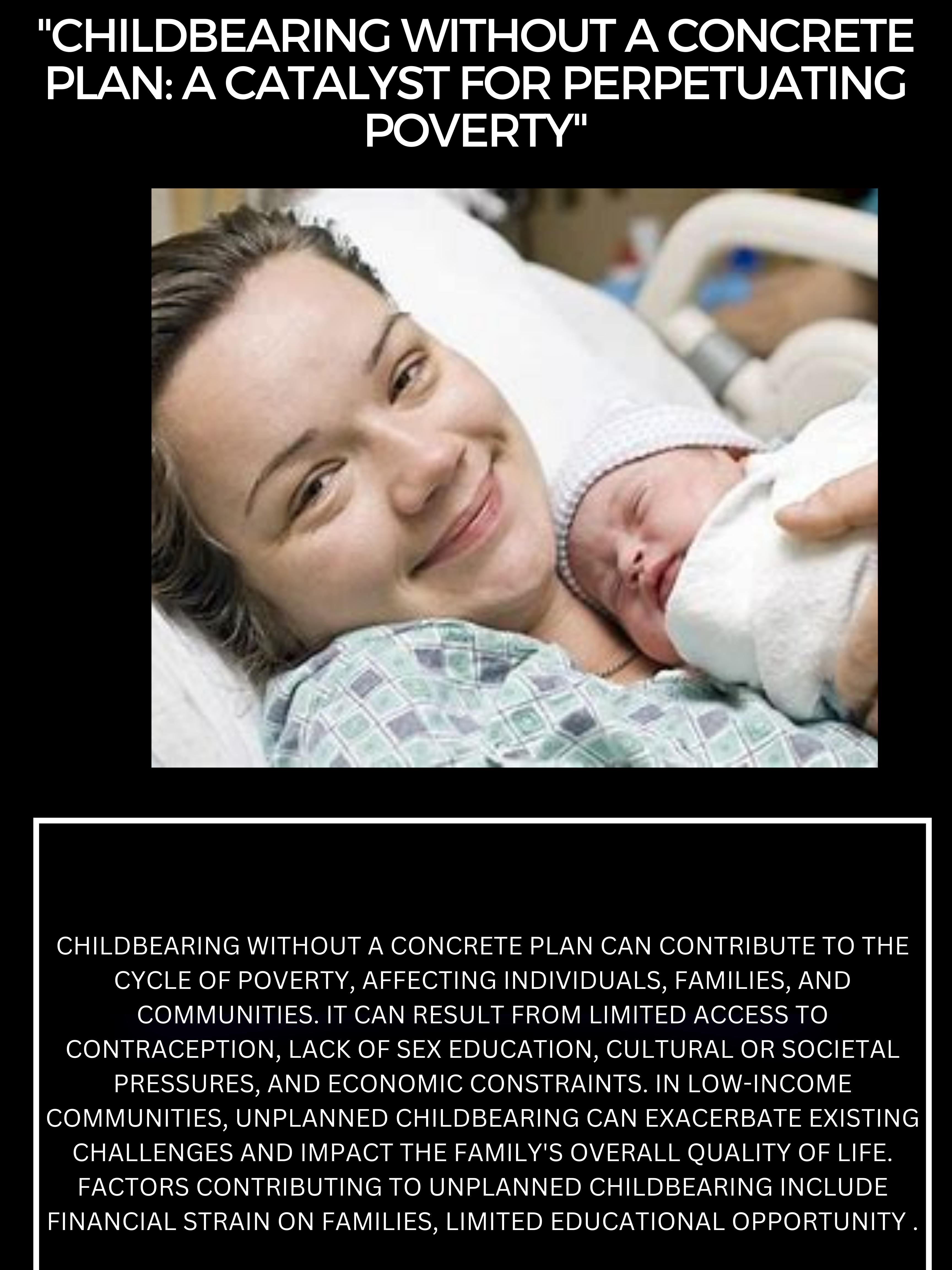
CHILD BEARING WITHOUT A CONCRETE PLAN:A CATALYST FOR PERPETUATING POVERTY
The decision to bring a child into the world is one of the most profound choices anyone can make. It is not merely a biological process but a complex interplay of emotional, social, and economic factors. Yet, when childbearing happens without a well-thought-out plan, it can become a significant contributor to the cycle of poverty. This phenomenon affects individuals, families, and entire communities, perpetuating inequalities and limiting opportunities for generations.
Understanding Childbearing Without a Concrete Plan
Childbearing without a concrete plan refers to having children without adequate preparation in terms of financial stability, emotional readiness, or access to essential resources like healthcare, education, and housing. In many cases, this is not a deliberate choice but a consequence of limited access to contraception, lack of sex education, cultural or societal pressures, and economic constraints.
In low-income communities, where resources are already scarce, unplanned childbearing can exacerbate existing challenges. Parents may struggle to provide for their children, creating a ripple effect that impacts the family's overall quality of life.
---
How Unplanned Childbearing Perpetuates Poverty
1. Financial Strain on Families Children require substantial resources—food, clothing, education, healthcare, and emotional support. For families living on limited incomes, the arrival of an unplanned child can push them deeper into financial hardship. The costs associated with raising a child often leave parents with fewer opportunities to save, invest, or improve their economic standing.
2. Limited Educational Opportunities In many cases, young parents who have children without planning are forced to abandon their education to care for their offspring. This lack of education limits their employment opportunities, relegating them to low-paying, unstable jobs. Consequently, their children may also lack access to quality education, perpetuating the cycle of poverty.
3. Strain on Social Systems Unplanned childbearing places additional pressure on social systems such as healthcare, education, and social welfare programs. Governments in impoverished regions often struggle to meet the growing demands of a rapidly increasing population, resulting in lower-quality services that further entrench poverty.
4. Impact on Child Development Children born into financially strained households are more likely to experience poor health, inadequate nutrition, and limited access to education. These factors negatively impact their development, reducing their chances of breaking free from the cycle of poverty.
5. Gender Inequality Unplanned pregnancies disproportionately affect women, particularly in patriarchal societies where women bear the brunt of child-rearing responsibilities. Early motherhood often curtails women's educational and career aspirations, limiting their potential to achieve economic independence.
---
Root Causes of Unplanned Childbearing
1. Lack of Access to Contraception In many impoverished communities, contraceptives are either unavailable or stigmatized. Women and couples are often unable to make informed choices about family planning, leading to unintended pregnancies.
2. Cultural and Religious Pressures Cultural norms and religious beliefs in some societies encourage early marriage and large families, often without consideration of the economic realities. These pressures can result in families having more children than they can reasonably support.
3. Inadequate Sex Education A lack of comprehensive sex education leaves many individuals unaware of reproductive health, contraception options, and the long-term consequences of unplanned pregnancies.
4. Economic Instability Poverty itself is a driver of unplanned childbearing. Women in financially unstable situations may lack the autonomy or resources to prevent pregnancies, perpetuating the cycle of poverty.
---
Breaking the Cycle: Practical Solutions
1. Promoting Comprehensive Sex Education Implementing education programs that teach about reproductive health, family planning, and the economic implications of childbearing is crucial. Knowledge empowers individuals to make informed decisions about their reproductive health.
2. Improving Access to Contraceptives Governments and non-governmental organizations must work to make contraceptives widely available and affordable. This includes addressing cultural stigmas and providing education on their proper use.
3. Economic Empowerment of Women Empowering women through education, vocational training, and access to financial resources is a critical step in breaking the cycle of poverty. Women with economic independence are more likely to plan their pregnancies and invest in their children's futures.
4. Encouraging Family Planning Programs Family planning initiatives should be culturally sensitive and tailored to the needs of specific communities. These programs should focus on raising awareness about the benefits of planned parenthood for individuals, families, and society.
5. Strengthening Social Support Systems Governments must invest in social infrastructure to support families, including affordable childcare, healthcare, and education. This creates a safety net that can alleviate the pressures of unplanned childbearing.
---
The Role of Policy and Advocacy
Policymakers play a pivotal role in addressing unplanned childbearing and its link to poverty. By enacting policies that promote reproductive health, gender equality, and economic opportunities, governments can create an environment where families can thrive. Advocacy efforts should focus on breaking the stigma around family planning and fostering a culture of informed decision-making.
--
In Conclusion,childbearing without a concrete plan is not just a personal challenge; it is a societal issue with far-reaching implications. It perpetuates poverty by creating barriers to education, employment, and upward mobility. Addressing this challenge requires a multifaceted approach, including education, access to resources, and systemic changes. By empowering individuals to make informed choices about childbearing, we can break the cycle of poverty
and pave the way for a brighter future for families and communities worldwide.



0 COMMENTS